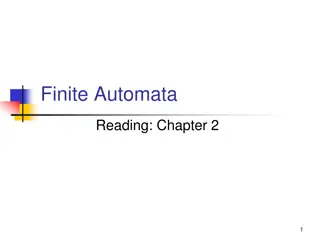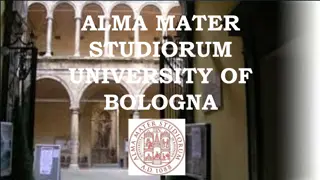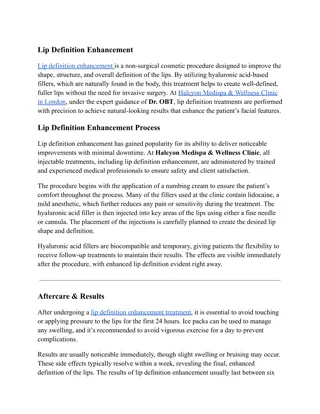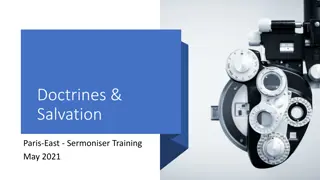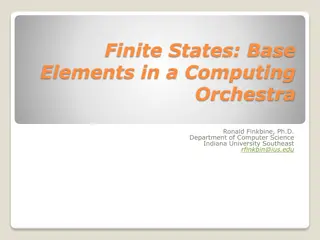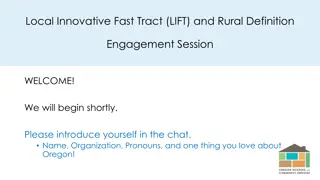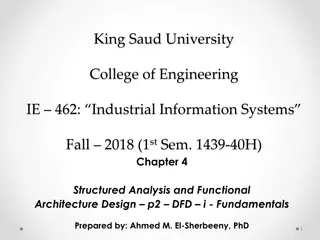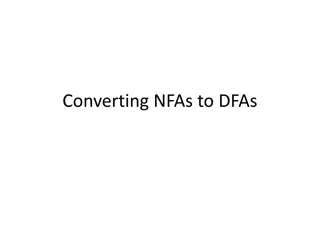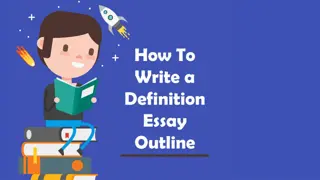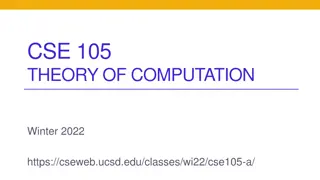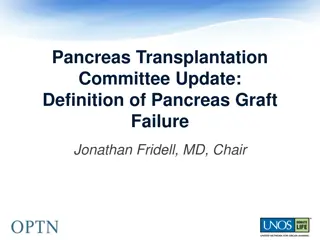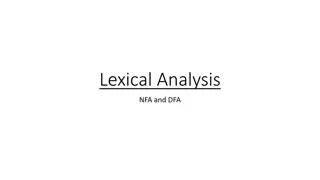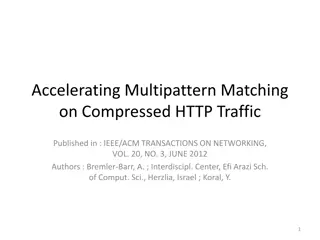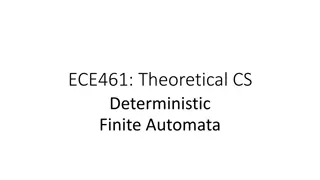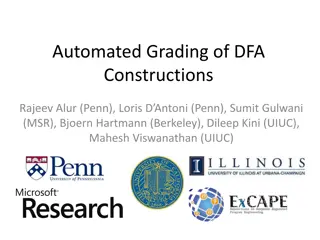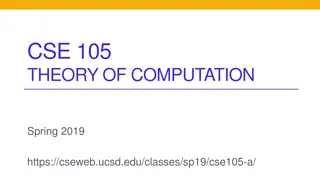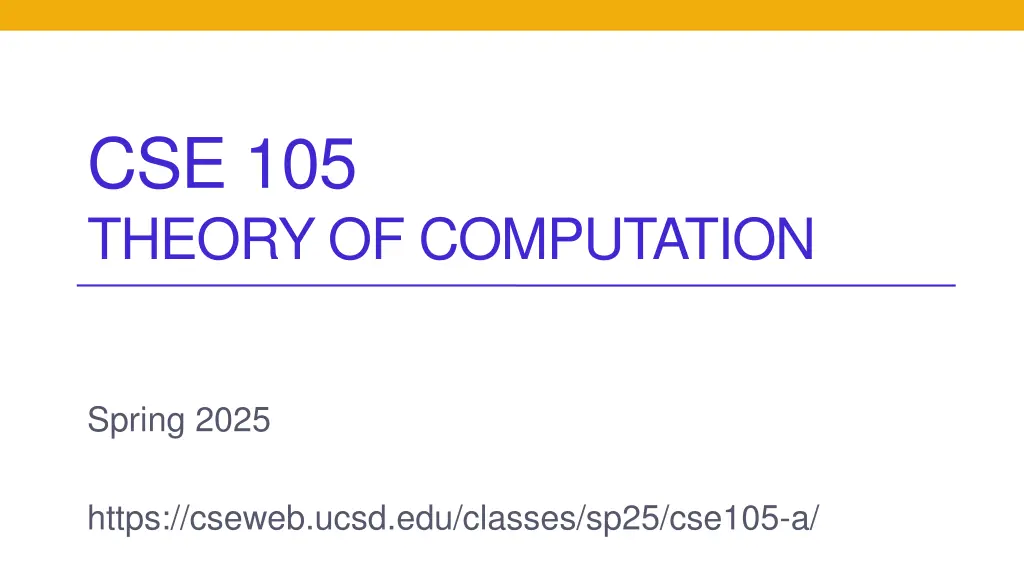
Theory of Computation 2025: Understanding Deterministic Finite Automaton
Explore the fundamentals of deterministic finite automata in the context of theory of computation, including formal definitions, state diagrams, and language acceptance criteria.
Download Presentation

Please find below an Image/Link to download the presentation.
The content on the website is provided AS IS for your information and personal use only. It may not be sold, licensed, or shared on other websites without obtaining consent from the author. If you encounter any issues during the download, it is possible that the publisher has removed the file from their server.
You are allowed to download the files provided on this website for personal or commercial use, subject to the condition that they are used lawfully. All files are the property of their respective owners.
The content on the website is provided AS IS for your information and personal use only. It may not be sold, licensed, or shared on other websites without obtaining consent from the author.
E N D
Presentation Transcript
CSE 105 THEORY OF COMPUTATION Spring 2025 https://cseweb.ucsd.edu/classes/sp25/cse105-a/
Today's learning goals Sipser Ch 1.1 Use and design a finite automaton via its - Formal definition - state diagram Identify the strings and languages accepted by a given finite automaton Design a finite automaton which accepts a given language Define the regular operations on languages
Deterministic Finite Automaton (DFA) Input: finite string over a fixed alphabet Output: "accept" or "reject" Accept state (double circle) Start state (triangle/arrow) Language of the machine is the set of strings it accepts
Deterministic finite automaton Input: finite string over a fixed alphabet Output: "accept" or "reject" Does this DFA accept the empty string ? A. Yes B. No C. I don't know
Deterministic finite automaton Input: finite string over a fixed alphabet Output: "accept" or "reject" Does this DFA accept the empty string ? Webclicker: https://webclicker.web.app login with your @ucsd.edu email class code PRDKWU student identifier = PID A. Yes B. No C. I don't know
Deterministic finite automaton Sipser p. 35 Def 1.5 No circles and arrows, same information!
Deterministic finite automaton Sipser p. 35 Def 1.5 Can there be more than one start state in a finite automaton? A. Yes, because of line 4. B. No, because of line 4. C. I don't know
Deterministic finite automaton Sipser p. 35 Def 1.5 How many outgoing arrows from each state? A. May be different number at each state. B. Must be 2. C. Must be |Q|. D. Must be | | E. I don't know.
An example Define M = is specified by its table of values: Input in Q x (q1,a) (q2,a) (q3,a) (q4,a) where the function Output in Q q3 q2 q3 q2 Input in Q x (q1,b) (q2,b) (q3,b) (q4,b) Output in Q q2 q2 q4 q4 Draw the state diagram for the DFA with this formal definition.
An example What's an example of a length 1 string accepted by this DFA? length 1 string rejected by this DFA? length 2 string accepted by this DFA? length 2 string rejected by this DFA?
An example What's the best description of the language recognized by this DFA? A. Starts with b and ends with a or b B. Starts with a and ends with a or b C. a's followed by b's D. More than one of the above E. I don't know. and using set notation?
An example This DFA recognizes the language of all strings of the form a's followed by b's i.e. { anbk| n,k 1}
Specifying an automaton ( {q1,q2,q3}, {a,b}, , q1, ? ) What state(s) should be in F so that the language of this machine is { w | ab is a substring of w}? A. {q2} B. {q3} C. {q1,q2} D. {q1,q3} E. I don't know.
Specifying an automaton ( {q1,q2,q3}, {a,b}, , q1, ? ) What state(s) should be in F so that the language of this machine is { w | b's never occur after a's in w}? A. {q2} B. {q3} C. {q1,q2} D. {q1,q3} E. I don't know.
Building DFA Typical questions Define a DFA which recognizes the given language L. or Prove that the (given) language L is regular.
Building DFA Example Define a DFA which recognizes { w | w has at least 2 a's}
Building DFA Example Define a DFA which recognizes { w | w has at most 2 a's}
Building DFA Remember States are our only (computer) memory. Design and pick states with specific roles / tasks in mind. "Have not seen any of desired pattern yet" "Trap state"
Justification? To prove that the DFA we build, M, actually recognizes the language L WTS L(M) = L (1) Is every string accepted by M in L? (2) Is every string from L accepted by M? or contrapositive version: Is every string rejected by M not in L.
A useful (optional) bit of terminology When is a string accepted by a DFA? Computation of M on w: where do we land when start at q0 and read each symbol of w one-at-a time? *( q, w ) = Recursively defined function
Regular languages Sipser p. 35 Def 1.5 For DFA M over the alphabet For each string w over , M either accepts w or rejects w The language recognized by M is the set of strings M accepts The languageof M is the set of strings M accepts L(M) = { w | w is a string over and M accepts w} Definition: A language is regular iff there is some finite automaton that recognizes exactly it.
Regular languages: bounds? Is every finite language regular? A. No: some finite languages are regular, and some are not. B. No: there are no finite regular languages. C. Yes: every finite language is regular. D. I don't know.
For next time Set up course tools: Gradescope, Piazza Find HW group members HW1 is due on Monday Read the assigned reading Review CSE 20 / Math 109 / CSE 21 / Sipser Ch 0 as needed.

